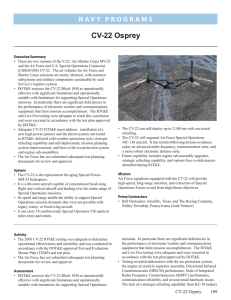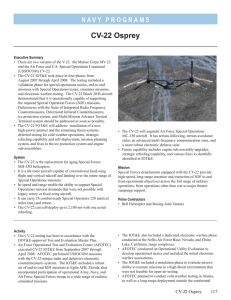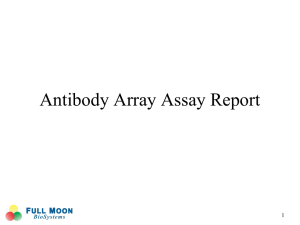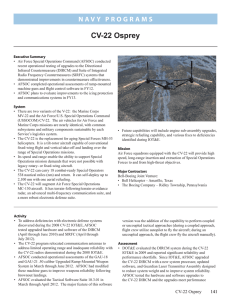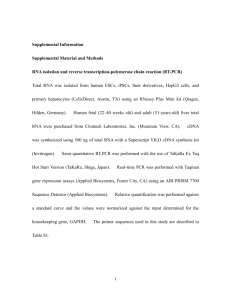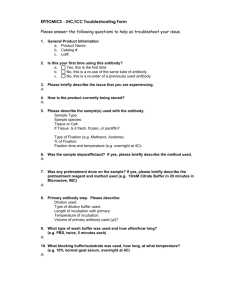ab123453 – CTIP2 (BCL11B) Human ELISA Kit
advertisement
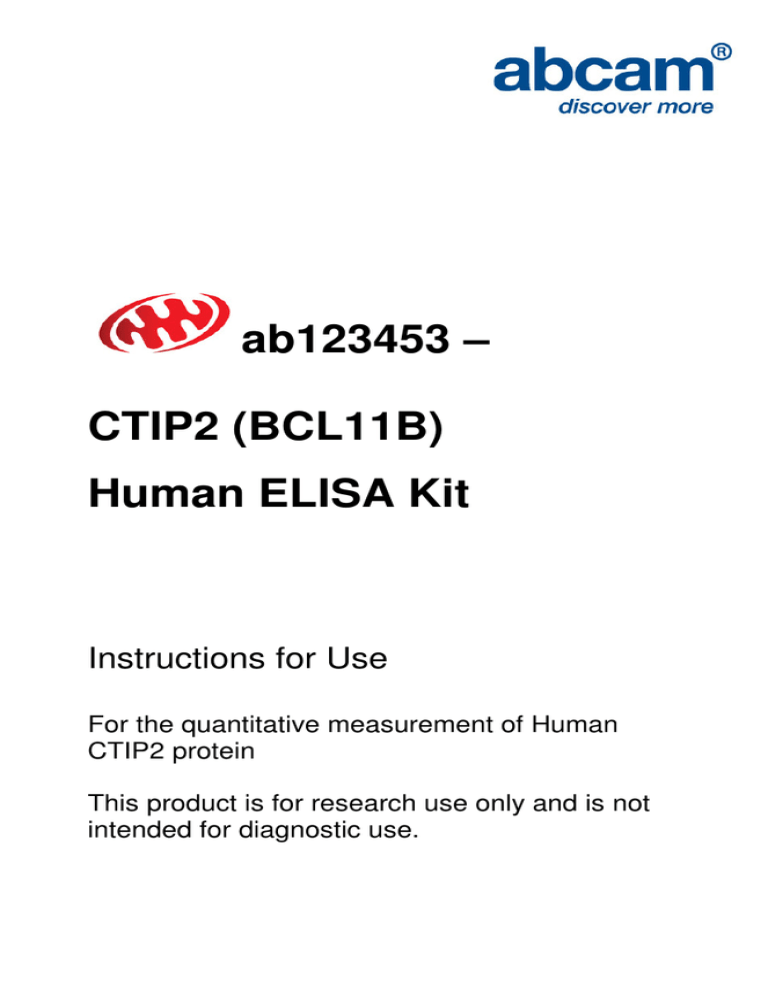
ab123453 – CTIP2 (BCL11B) Human ELISA Kit Instructions for Use For the quantitative measurement of Human CTIP2 protein This product is for research use only and is not intended for diagnostic use. 1 Table of Contents 1. Introduction 3 2. Assay Summary 5 3. Kit Contents 6 4. Storage and Handling 6 5. Additional Materials Required 7 6. Preparation of Reagents 8 7. Sample Preparation 10 8. Assay Procedure 12 9. Data Analysis 15 10. Specificity 19 11. Troubleshooting 21 2 1. Introduction Principle: ab123453 Immunosorbent CTIP2 Assay) kit Human is an ELISA in vitro (Enzyme-Linked enzyme-linked immunosorbent assay for the quantitative measurement of Human CTIP2 in cell and tissue lysates. The assay employs an antibody specific for Human CTIP2 coated onto 96-well plate strips. Standards and samples are pipetted into the wells and the analyte present in the sample is bound to the wells by the immobilized antibody. The wells are washed and an anti-CTIP2 primary detector antibody is added. After washing away unbound primary detector antibody, HRP-conjugated secondary detector antibody specific for the primary detector antibody is pipetted to the wells. The wells are again washed, a TMB substrate solution is added to the wells and color develops in proportion to the amount of analyte bound. The developing blue color is measured at 600 nm. Optionally the reaction can be stopped by adding hydrochloric acid which changes the color from blue to yellow and the intensity can be measured at 450 nm. 3 Background: Ctip2 (encoded by BCL11B or CTIP2 gene) is a C2H2-type zinc finger protein and is closely related to Ctip1. Over expression of these proteins has been linked to B cell malignanices. Ctip2 shows a very high level of expression in layer V in both corticospinal motor neurons (CSMN) and corticotectal neurons. Studies have shown that CTIP2 has critical roles in the immune system, controlling T cell subtype specification and survival in the developing thymus. Ctip2 plays a critical role in the development of CSMN axonal projections to the spinal cord in vivo. ChIP assays have revealed that expression of CTIP2 in mammalian cells resulted in deacetylation of histones H3 and/or H4 that were associated with the promoter region of a reporter gene. SIRT1, a class III histone deacetylase, was found to interact directly with CTIP2 and was recruited to the promoter template in a CTIP2-dependent manner. CTIP2 is also a regulator of the development of skin and ameloblast differentiation and in tooth development. 4 2. Assay Summary Bring all reagents to room temperature. Prepare all the reagents, samples, and standards as instructed. Add 50 µL standard or sample to each well used. Incubate 2 hours at room temperature. Aspirate and wash each well two times. Add 50 µL prepared 1X Detector Antibody to each well. Incubate 1 hour at room temperature. Aspirate and wash each well two times. Add 50 µL prepared 1X HRP Label to each well. Incubate 1 hour at room temperature. Aspirate and wash each well three times. Add 100 µL TMB Development Solution to each well. Immediately begin recording the color development with elapsed time for 15 minutes at 600 nm. Alternatively add a Stop solution at a user-defined time and read at 450 nm. 5 3. Kit Contents Item Quantity 20X Buffer 20 mL Extraction Buffer 25 mL 10X Blocking Buffer TMB Development Solution 6 mL 12 mL 10X CTIP2 Detector Antibody 1 mL 10X HRP Label 1 mL Human CTIP2 Standard (1000 ng) 1 vial CTIP2 Microplate 96 wells (12 x 8 antibody coated well strips) 4. Storage and Handling Store all components at 4°C. This kit is stable for at least 6 months from receipt. After reconstitution the standard should be stored at -80°C. Unused microplate strips should be returned to the pouch containing the desiccant and resealed. 6 5. Additional Materials Required • Microplate reader capable of measuring absorbance at 600 nm (or 450 nm after addition of Stop solution - not supplied). • Method for determining protein concentration (BCA assay recommended). • Deionized water • Multi and single channel pipettes • PBS (1.4 mM KH2PO4, 8 mM Na2HPO4, 140 mM NaCl, 2.7 mM KCl, pH 7.3) • Tubes for standard dilution • Stop solution (optional) – 1N hydrochloric acid • Optional plate shaker for all incubation steps • Wellplate cover or seals 7 6. Preparation of Reagents 6.1 Equilibrate all reagents and samples to room temperature (18o 25 C) before use. 6.2 Prepare 1X Wash Buffer by adding 20 mL 20X Buffer to 380 mL nanopure water. Mix gently and thoroughly. 6.3 Prepare 1X Incubation Buffer by adding 6 mL 10X Blocking Buffer to 54 mL 1X Wash Buffer, mix by gentle inversion. Unused 1X Incubation buffer may be stored at -20°C for 6 months after performing the ELISA. 6.4 Prepare the 1X Detector Antibody by diluting the 10X CTIP2 Detector Antibody 10-fold with 1X Incubation Buffer immediately prior to use. Prepare 0.5 mL for each 8 well strip used. 6.5 Prepare the 1X HRP label by diluting the 10X HRP Label 10fold with 1X Incubation Buffer immediately before use. Prepare 0.5 mL for each 8 well strip used. 6.6 Reconstitute the standard by adding 1 mL 1X Incubation buffer to the stock Human CTIP2 standard (1000 ng) tube by pipette. Allow to sit for 10 minutes and repeat pipetting to ensure thorough reconstitution. This 1000 ng/mL stock of standard material is then used to generate a standard curve in labeled 8 tubes as described below. Any remaining stock material can o be stored at -80 C. 6.7 To prepare serially diluted standards, label six tubes #2-7. Label the reconstituted stock Human CTIP2 standard from step 6.6 tube #1. Add 150 µL L of 1X Incubation buffer to each of tubes #2 through #7. Transfer 150 µL L from tube #1 to tube #2. Mix thoroughly. With a fresh pipette tip transfer 150 µL from #2 to #3. Mix thoroughly. Repeat for Tubes #4 through #7. Use 1X Incubation buffer as the zero standard tube labeled #8. Use fresh standards for each assay. 9 7. Sample Preparation Note: Extraction buffer can be supplemented with phosphatase inhibitors, PMSF and protease inhibitor cocktail prior to use. Supplements should be used according to manufacturer’s instructions. 7.1 Cell lysates 7.1.1 Collect non adherent cells by centrifugation or scrape to collect adherent cells from the culture flask. Typical centrifugation conditions for cells are o 500 x g for 10 min at 4 C. 7.1.2 Rinse cells twice with PBS. 7.1.3 Solubilize cell pellet at 2x10 /mL in Extraction Buffer. 7.1.4 Incubate on ice for 20 minutes. 7 16,000 x g for 20 minutes at 4°C. Centrifuge at Transfer the supernatants into clean tubes and discard the pellets. Assay samples immediately or aliquot and store at -80°C. The sample protein concentration in the extract may be quantified using a protein assay. 10 7.2 Tissue lysates 7.2.1 Tissue lysates are typically prepared by homogenization of tissue that is first minced and thoroughly rinsed in PBS to remove blood (dounce homogenizer recommended). 7.2.2 Suspend the homogenate to 25 mg/mL in PBS. 7.2.3 Solubilize the homogenate by adding 4 volumes of Extraction Buffer to a sample protein concentration of 5 mg/mL. 7.2.4 Incubate on ice for 20 minutes. 16,000 x g for 20 minutes at 4°C. Centrifuge at Transfer the supernatants into clean tubes and discard the pellets. Assay samples immediately or aliquot and store at -80°C. The sample protein concentration in the extract may be quantified using a protein assay. The sample should be diluted to within the working range of the assay in 1X Incubation Buffer. As a guide, typical ranges of sample concentration for commonly used sample types are shown below in Data Analysis. 11 8. Assay Procedure Equilibrate all reagents and samples to room temperature before use. It is recommended all samples and standards be assayed in duplicate. 8.1 Prepare all reagents, working standards, and samples as directed in the previous sections. 8.2 Remove unused microplate strips from the plate frame, return them to the foil pouch containing the desiccant pack, and seal. 8.3 Add 50 µL of each serially diluted Human CTIP2 standard (tubes 2 – 8) or test sample per well. It is recommended to include a dilution series of a control (normal) sample as a reference. Also include a 1X Incubation buffer as a zero standard. 8.4 Cover/seal the plate and incubate for 2 hours at room temperature. If available use a plate shaker for all incubation steps at 300 rpm. 8.5 Aspirate each well and wash, repeat this once more for a total of two washes. Wash by aspirating or decanting from wells then dispensing 300 µL 1X Wash buffer into each well as described above. Complete removal of 12 liquid at each step is essential to good performance. After the last wash, remove the remaining buffer by aspiration or decanting. Invert the plate and blot it against clean paper towels to remove excess liquid. 8.6 Immediately before use prepare sufficient (0.5 mL/strip used) 1X Detector Antibody (step 6.4) in 1X Incubation buffer. Add 50 µL 1X Detector antibody to each well used. Cover/seal the plate and incubate for 1 hour at room temperature. If available use a plate shaker for all incubation steps at 300 rpm. 8.7 Repeat the aspirate/wash procedure above. 8.8 Immediately before use prepare sufficient (0.5 mL/strip used) 1X HRP label in 1X Incubation buffer (step 6.5). Add 50 µL 1X HRP label to each well used. Cover/seal the plate and incubate for 1 hour at room temperature. If available use a plate shaker for all incubation steps at 300 rpm. 8.9 Repeat the aspirate/wash procedure above, however, performing a total of three washes. 8.10 Add 100 µL TMB Development Solution to each empty well and immediately record the blue color development 13 with elapsed time in the microplate reader prepared with the following settings: Mode: Wavelength: Time: Interval: Shaking: Kinetic 600 nM up to 15 min. 20 sec. - 1 min. Shake between readings Alternative– In place of a kinetic reading, at a user defined, time record the endpoint OD data at (i) 600 nm or (ii) stop the reaction by adding 100 µL stop solution (1N HCl) to each well and record the OD at 450 nm. 8.11 Analyze the data as described below. 14 9. Data Analysis Average the duplicate standard readings and plot against their concentrations after subtracting the zero standard reading. Draw the best smooth curve through these points to construct a standard curve. Most plate reader software or graphing software can plot these values and curve fit. A four parameter algorithm (4PL) usually provides the best fit, though other equations can be examined to see which provides the most accurate (e.g. linear, semi-log, log/log, 4 parameter logistic). Read CTIP2 protein concentrations for unknown and control samples from the standard curve plotted. Samples producing signals greater than that of the highest standard should be further diluted in 1X Incubation buffer and reanalyzed, then multiplying the concentration found by the appropriate dilution factor. TYPICAL STANDARD CURVE - For demonstration only. Figure 1. Example standard curve. A dilution series of recombinant CTIP2 in the working range of the assay. 15 TYPICAL SAMPLE RANGE - For demonstration only. mOD/min (600nm) 1000 100 10 1 0.01 0.1 1 Jurkat cell lysate (mg/mL) Figure 2. Example curve for endogenous CTIP2 expression in Jurkat cells. Typical working ranges Sample Type Range Whole Jurkat cell culture extract 0.015 - 1 mg/mL CTIP2 standard 2 – 1000 ng/mL SENSITIVITY Determined minimum detectable dose = 2 pg/mL CTIP2 standard. 16 LINEARITY OF DILUTION Linearity of dilution determined by comparing dilution series of Jurkat extract with standard CTIP2 protein (starting extract concentration is 1 mg/mL). Sample Type % Expected Value 1:1 100 1:2 113 1:4 94 1:8 95 1:16 97 1:32 83 1:64 88 REPRODUCIBILITY Parameter CV% Intra (n=8) 9.6 Inter (n=3 days 8 replicates eac) 13.0 17 RECOVERY CTIP2 is an intracellular marker, however interference by cell culture media and serum were determined. Sample Type Average Recovery (%) Range (%) Cell culture media 90 80-105 10% Serum 94 78-117 18 10. Specificity Species– Human reactive. Specificity of this ELISA was confirmed by analyzing various samples from different species known to contain high levels of CTIP2 expression, see Figure 3. The specificity of the CTIP2 detector antibody in this kit was independently confirmed by Western blot, ICC and Flow cytometry, see Figure 4. A B Figure 3. Demonstration of the specificity of this ELISA. (A) Endogenous expression of CTIP2 in Jurkat cells is higher than other non-lymphocyte cells such as Hela (Human carcinoma) and NIH3T3 (mouse fibroblast), and C6 (rat glioma). (B) CTIP2 expression is detectable in mouse brain lysate but not in rat brain lysate. 19 Figure 4. Demonstration of the specificity of the detector antibody used in this kit. (A) Western blot using the CTIP2 detector antibody at 1µg/mL: Jurkat cell lysate and HeLa cell lysate, each were loaded at 16µg/lane. (B) Analysis of CTIP2 staining in Jurkat cells by ICC: left panel DAPI (red for contrast) with no primary antibody and right panel CTIP2 detector primary antibody at 1 µg/mL (green), both samples contain 488 labeled secondary antibody. (C) Analysis of CTIP2 staining in Jurkat cells by Flow: Black unstained, red no primary and blue CTIP2 detector antibody at 1µg/mL, red and blue include 488 dye labeled secondary. 20 11. Troubleshooting Problem Poor standard curve Cause Solution Inaccurate Pipetting Check pipettes Improper standard dilution Prior to opening, briefly spin the stock standard tube and dissolve the powder thoroughly by gentle mixing Incubation times too brief Ensure sufficient incubation times; change to overnight standard/sample incubation Inadequate reagent volumes or improper dilution Check pipettes and ensure correct preparation Plate is insufficiently washed Review manual for proper wash technique. If using a plate washer, check all ports for obstructions Contaminated wash buffer Make fresh wash buffer Improper storage of the ELISA kit Store your reconstituted standards at -80°C, all other assay components 4°C. Keep substrate solution protected from light Low Signal Large CV Low sensitivity 21 22 UK, EU and ROW Email: technical@abcam.com Tel: +44 (0)1223 696000 www.abcam.com US, Canada and Latin America Email: us.technical@abcam.com Tel: 888-77-ABCAM (22226) www.abcam.com China and Asia Pacific Email: hk.technical@abcam.com Tel: 108008523689 (中國聯通) www.abcam.cn Japan Email: technical@abcam.co.jp Tel: +81-(0)3-6231-0940 www.abcam.co.jp Copyright © 2012 Abcam, All Rights Reserved. The Abcam logo is a registered trademark. 23 All information / detail is correct at time of going to print.

